Exploring the Heart of the Khumbu Region: Namche Bazaar
The Sherpa Capital is where the stories of mountains are penned. It is a place of vibrant culture, impeccable mountains and unbeatable Sherpas.
The Sherpa Capital is where the stories of mountains are penned. It is a place of vibrant culture, impeccable mountains and unbeatable Sherpas.
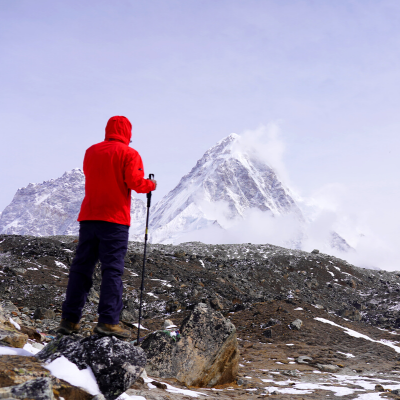
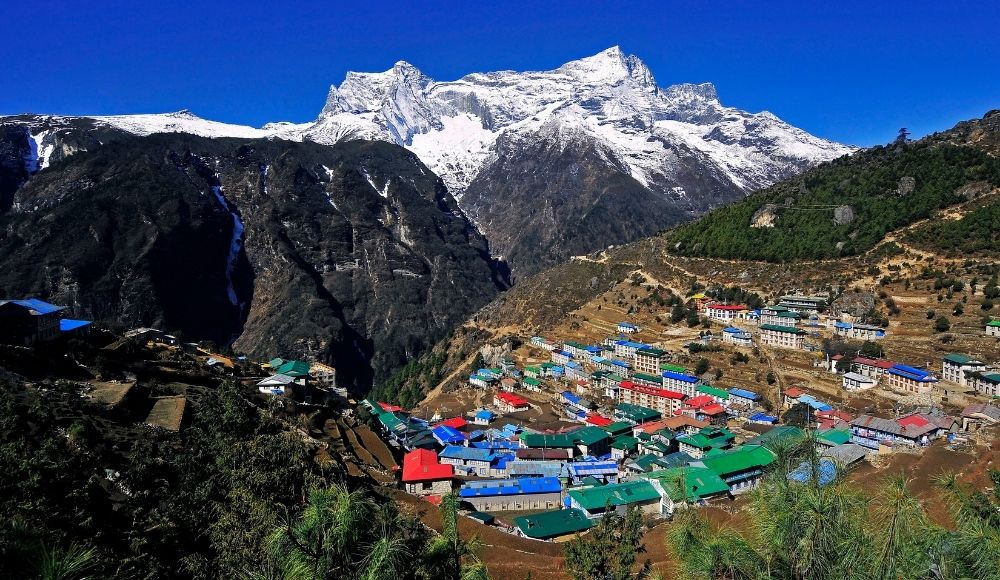
Nestled within the soaring peaks of the Nepalese Himalayas lies Namche Bazaar, a bustling mountain town that serves as the gateway to the Everest Base Camp and the heart of the Khumbu region. At an elevation of 3,440 meters (11,286 feet), Namche Bazaar is not only the primary trading center and hub for the local Sherpa community, but it's also a haven for trekkers and mountaineers seeking adventure in the world's most spectacular mountain range.
This picturesque town, with its colorful buildings and winding stone-paved paths, offers an unforgettable experience for visitors seeking a taste of authentic Sherpa culture, as well as access to the numerous trekking routes that crisscross the region. The town's unique location, vibrant atmosphere, and rich cultural heritage make it an essential stop for anyone venturing into the Himalayas.
Namche Bazaar's unparalleled location, vibrant atmosphere, and cultural richness make it a must-visit destination for anyone venturing into the Khumbu region. As the gateway to Everest Base Camp and the heart of the Sherpa community, this captivating town promises an unforgettable experience that will leave you with a deep appreciation for the wonders of the Himalayas and the people who call them home.
Unique Location:
Namche Bazaar's location is nothing short of spectacular. Situated at an altitude of 3,440 meters (11,286 feet), the town is nestled within an amphitheater-like valley surrounded by majestic snow-capped mountains. Its terraced layout offers panoramic views of the stunning peaks, including Kongde Ri, Thamserku, and the awe-inspiring Mount Everest. This strategic location makes Namche Bazaar the perfect starting point for trekkers and mountaineers, providing easy access to the numerous trails in the region and serving as an essential acclimatization stop for those heading higher into the Himalayas.
Vibrant Atmosphere:
Despite its remote location, Namche Bazaar bustles with energy and excitement. As the main trading center for the Khumbu region, the town attracts traders, trekkers, mountaineers, and tourists alike, creating a lively and multicultural atmosphere. The colorful buildings, teahouses, cafes, and shops that line the narrow, stone-paved streets add to the town's charm and vibrancy. The weekly Saturday market, where locals and traders gather to buy and sell goods ranging from food and clothing to mountaineering equipment, is a testament to Namche's dynamic spirit.
Cultural Richness:
Namche Bazaar is also a treasure trove of cultural heritage, steeped in the traditions of the Sherpa people who have called the region home for centuries. The town offers an authentic glimpse into Sherpa life, from their unique customs and religious beliefs to their traditional cuisine and crafts. Visitors can explore ancient monasteries, visit cultural museums, and participate in local festivals to immerse themselves in the rich tapestry of Sherpa culture. Moreover, Namche Bazaar is an excellent place to learn about the region's mountaineering history, showcasing the stories of legendary climbers like Tenzing Norgay and Sir Edmund Hillary, who conquered Everest and put the town on the global map.
Our goal in creating this blog post is to provide you with a detailed and comprehensive guide on what to expect when visiting Namche Bazaar and how to make the most of your time in this enchanting mountain town. We understand that traveling to such a remote and unique location can be both exciting and challenging, so we aim to equip you with all the essential information, tips, and insights that will help you navigate and appreciate Namche Bazaar to the fullest.
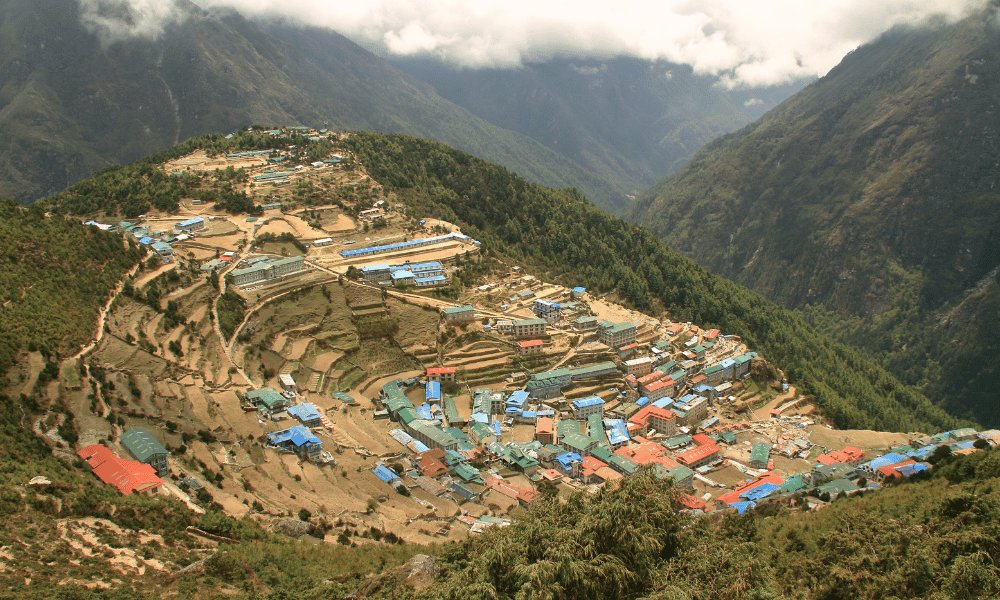
In this guide, we'll cover a wide range of topics, including:
The different ways to reach Namche Bazaar and the permits required for your journey
A brief history of the town and its role in the development of the Khumbu region
Accommodation options, from traditional tea houses to luxury hotels
Local cuisine and dining recommendations for a true taste of Sherpa culture
The rich traditions, customs, and religious sites of the Sherpa people
Top attractions and activities to explore during your stay in Namche Bazaar
The importance of acclimatization and tips for staying healthy at high altitude
Responsible tourism practices to ensure a sustainable and eco-friendly visit
With this blog post, we hope to inspire and prepare you for an unforgettable adventure in Namche Bazaar, offering a deep dive into the town's vibrant atmosphere, cultural richness, and breathtaking natural beauty. Whether you're an avid trekker, a mountain lover, or a curious traveler seeking new experiences, this guide will help you make the most of your journey and leave you with memories that will last a lifetime.
Namche bazaar serves a feast to your eyes and all other senses and getting there is just as rewarding. Whether you go there by air or on foot, you are sure to have a memory of a lifetime.
The quickest and most convenient way to reach Namche Bazaar is by air. Fly from Kathmandu to Lukla, a small town with the Tenzing-Hillary Airport, which is considered one of the most thrilling airports in the world due to its short, high-altitude runway. The flight takes approximately 30 minutes and offers stunning aerial views of the Himalayan peaks. From Lukla, you'll begin your trek to Namche Bazaar, which usually takes two days, with an overnight stop in Phakding.
Please note that flights to Lukla are weather-dependent, and delays or cancellations are common. It's a good idea to allocate some buffer days in your itinerary to account for any disruptions.
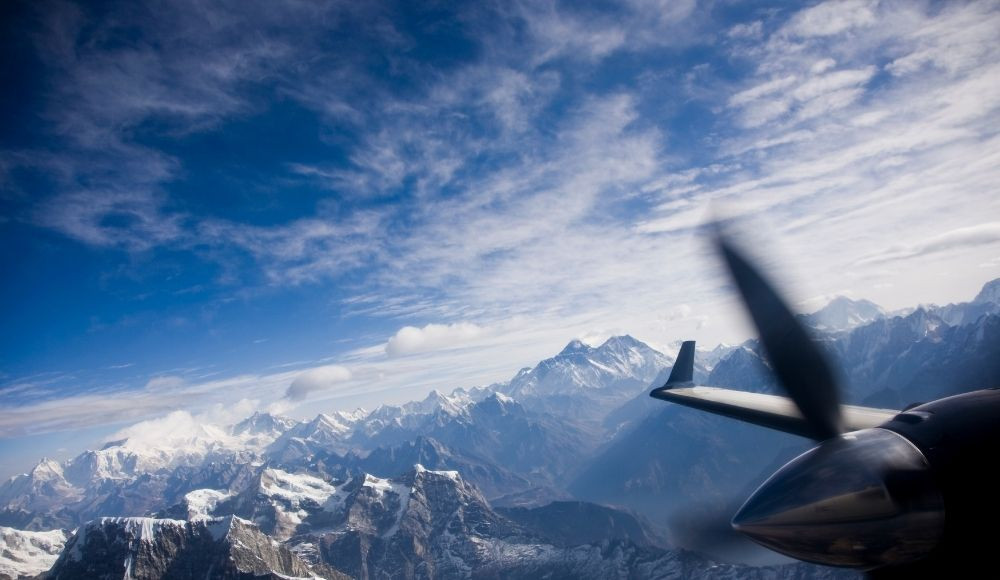
For those seeking a more extended trekking experience or wishing to avoid flying to Lukla, it's possible to reach Namche Bazaar on foot from Jiri or Salleri. These routes are less popular and more challenging, but they offer a more immersive and authentic trekking experience through the lower Solu region. The trek from Jiri to Namche Bazaar typically takes 7-8 days, while the trek from Salleri takes about 5-6 days. Both options allow for gradual acclimatization and provide ample opportunities to witness the diverse landscapes, flora, and fauna of the region.
To visit Namche Bazaar and trek in the Khumbu region, you'll need to obtain the following permits:
TIMS Card (Trekkers' Information Management System): This card is mandatory for all trekkers in Nepal and can be obtained in Kathmandu or Pokhara at the Nepal Tourism Board offices. The cost is $10 for individual trekkers and $20 for those joining an organized group.
Sagarmatha National Park Entry Permit: This permit is required to enter the national park, where Namche Bazaar is located. You can obtain the permit at the park's entrance in Monjo, or you can get it in advance at the Nepal Tourism Board office in Kathmandu. The fee is NPR 3,000 (approximately $30) for foreign nationals, and it's valid for a single entry.
Khumbu Pasang Lhamu Rural Municipality Permit: In addition to the TIMS Card and the Sagarmatha National Park Entry Permit, trekkers visiting the Khumbu region, including Namche Bazaar, also need to obtain the Khumbu Pasang Lhamu Rural Municipality Permit. The Khumbu Pasang Lhamu Rural Municipality Permit can be obtained in Lukla upon arrival. The cost of the permit is NPR 2,000 (approximately $20) for foreign nationals. This permit is used to support local infrastructure, environmental conservation efforts, and the overall development of the region.
Ensure you have a valid passport and multiple passport-sized photos for your permits, and always carry your permits with you during your trek, as you may be asked to show them at various checkpoints along the way.
Namche Bazaar has come a long way from its humble beginnings as a small trading post for the local Sherpa communities. Historically, the town served as a key junction on the ancient salt trade route between Tibet and Nepal. Sherpas from the surrounding villages would come to Namche to trade their agricultural produce for essential goods brought by traders from Tibet.
In 1953, Sir Edmund Hillary and Tenzing Norgay conquered Mount Everest, thrusting the Khumbu region and Namche Bazaar into the global spotlight. This significant event marked the beginning of a new era for the town, as more and more trekkers, mountaineers, and tourists began to visit the area. Namche Bazaar quickly evolved into the primary stopover point and the main acclimatization hub for those attempting to summit Everest or trekking to Everest Base Camp.
Today, Namche Bazaar has transformed into a bustling and vibrant town, complete with modern amenities, while still maintaining its traditional Sherpa charm. The town's evolution has led to a thriving local economy, with numerous teahouses, lodges, restaurants, and shops catering to the ever-growing number of visitors.
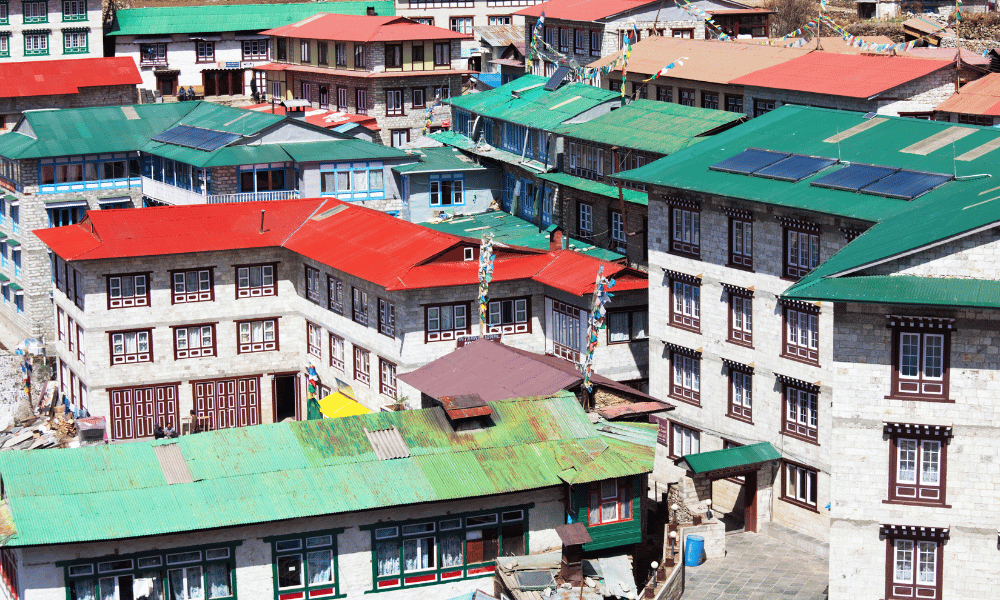
Namche Bazaar has played a pivotal role in the development of the Khumbu region. As the primary trading center and the main tourist hub, the town has significantly contributed to the region's economic growth. The influx of tourists has created numerous job opportunities for the local Sherpa community, including guiding, portering, and hospitality services.
Additionally, Namche Bazaar has become the center for various development and conservation projects in the Khumbu region. Sir Edmund Hillary established the Himalayan Trust in 1960, which has since been actively involved in building schools, hospitals, and infrastructure in the area. The trust also supports environmental conservation efforts, such as reforestation and waste management initiatives.
Namche Bazaar's role as a gateway to the Everest region has also helped raise global awareness of the challenges faced by the local Sherpa community and the fragile mountain ecosystem. This increased awareness has spurred international support and collaboration in addressing issues like climate change, preserving cultural heritage, and promoting sustainable tourism practices.
Over the years, many lodges and tea houses have opened in Namche Bazaar to accommodate tourists of every kind with all sorts of preferences. Depending on your budget and needs, you can pick from one of the many accommodation options in Namche Bazaar.
Tea houses and lodges are the most common accommodation options in Namche Bazaar, offering a cozy and authentic experience for trekkers and travelers. These family-run establishments typically provide basic amenities, such as a private or shared room with comfortable beds, warm blankets, and shared bathroom facilities. Tea houses also have a common dining area where you can enjoy home-cooked meals and mingle with fellow trekkers. Staying at a tea house not only offers a glimpse into the local Sherpa culture but also supports the community's livelihood.
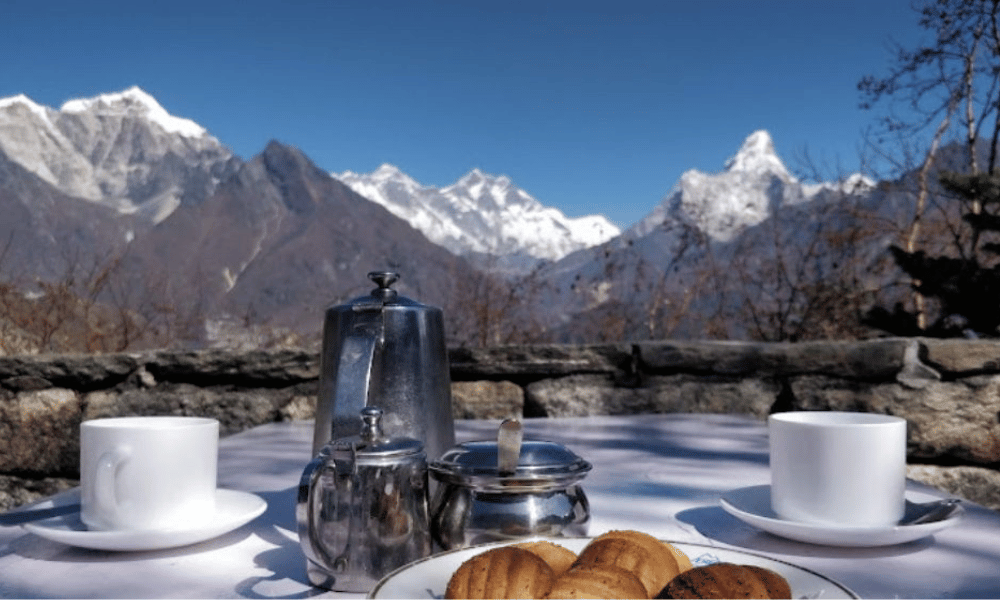
For travelers seeking a higher level of comfort and amenities, there are a few luxury hotels and lodges available in Namche Bazaar. These upscale accommodations provide well-appointed rooms with en-suite bathrooms, heating, Wi-Fi, and other modern conveniences. Some luxury lodges even offer spa services, fine dining options, and stunning mountain views from private balconies. While these accommodations come at a higher price, they ensure a comfortable and indulgent stay amidst the rugged beauty of the Himalayas.
Budget: Determine your budget for accommodations and choose a tea house, lodge, or hotel that aligns with your financial constraints. Keep in mind that prices tend to increase as you go higher in altitude.
Amenities: Prioritize the amenities that are most important to you, such as Wi-Fi, hot showers, or en-suite bathrooms, and look for accommodations that offer these features.
Reviews and recommendations: Consult online reviews and seek recommendations from fellow travelers or trekking agencies to find reliable and well-regarded accommodation options.
Advance booking: During peak trekking seasons (spring and autumn), Namche Bazaar can become quite crowded. It's a good idea to book your accommodation in advance to secure a room in your preferred tea house or hotel.
Location: Choose a place to stay that is conveniently located near the town center, as it will provide easy access to shops, restaurants, and local attractions. However, if you prefer a quieter setting, consider accommodations situated on the outskirts of town.
Eco-friendly practices: Opt for accommodations that prioritize sustainable and environmentally friendly practices, such as waste management, energy conservation, and sourcing local produce.
By considering these factors, you'll be able to find the perfect accommodation that suits your needs, preferences, and budget, ensuring a comfortable and memorable stay in Namche Bazaar.
Once you have reached Namche bazaar, you will have multiple options for food and dining. You can choose to enjoy the local specialties or indulge in western comfort foods. Whatever your pick may be, you won't be disappointed by the flavors of this place.
Namche Bazaar offers a variety of culinary delights, giving visitors a chance to savor the flavors of traditional Sherpa and Nepali cuisine. Some must-try dishes include:
Dal Bhat: A staple meal in Nepal, consisting of steamed rice, lentil soup (dal), and a variety of vegetable or meat side dishes (curries). It's a nutritious, filling, and flavorful meal that provides the energy needed for trekking in the mountains.
Sherpa Stew (Shyakpa): A hearty and warming dish made from a combination of potatoes, vegetables, meat (typically yak or mutton), and Tibetan noodles. This one-pot meal is perfect for cold mountain evenings.
Mo:mo: These Nepali-style dumplings are filled with minced meat, vegetables, or cheese and are served steamed or fried, accompanied by a spicy dipping sauce.
Tibetan Bread: A deep-fried or pan-fried bread that's often served for breakfast with honey, jam, or eggs. It's a delicious and satisfying way to start the day.
Yak Cheese: A local specialty, yak cheese is a popular snack or ingredient in various dishes. You can find it in shops, and bakeries, or served as part of a meal in tea houses and lodges.
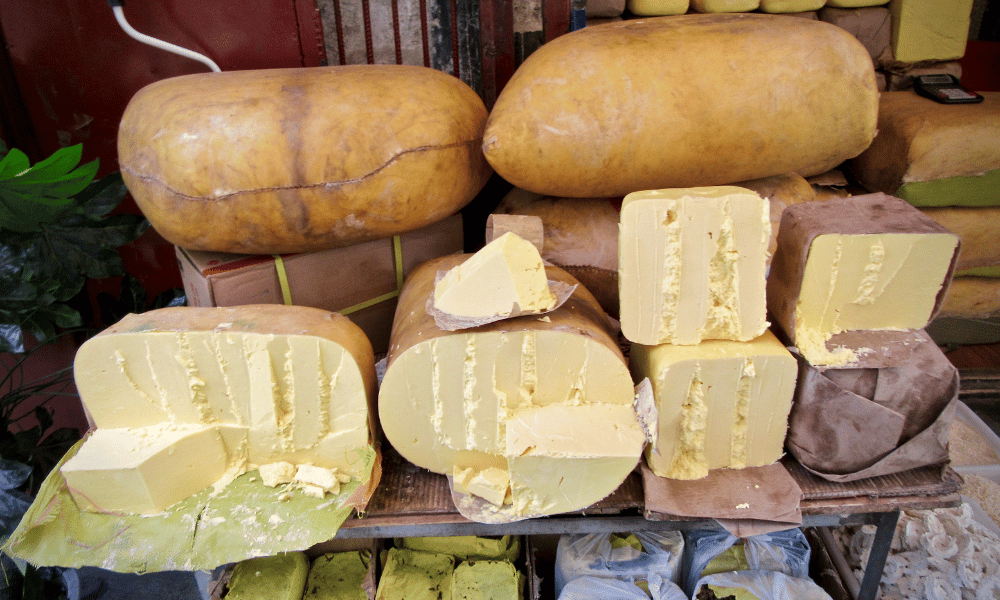
Despite its remote location, Namche Bazaar boasts an impressive array of cafes, bakeries, and restaurants that cater to diverse tastes and preferences. You can find everything from traditional Sherpa and Nepali dishes to international favorites like pizza, pasta, and sandwiches.
Some popular spots in town include:
The Everest Bakery: Known for its delicious pastries, bread, and cakes, this bakery is an excellent place to enjoy a sweet treat or a light meal.
The Himalayan Java Coffee: This cozy cafe offers a range of hot beverages, including freshly brewed coffee, as well as snacks and light meals in a comfortable setting.
Sherpa Barista Bakery and Cafe: With its selection of fresh bread, pastries, and sandwiches, this bakery is an ideal spot for breakfast or a quick bite.
Namche Bazaar's weekly market: On Saturdays, the town comes alive with a vibrant market where locals and traders gather to buy and sell food, clothes, and various other goods. It's a great place to try local street food and immerse yourself in the bustling atmosphere.
Many tea houses, lodges, and restaurants in Namche Bazaar cater to dietary restrictions such as vegetarian, vegan, and gluten-free options. However, it's essential to communicate your dietary needs clearly to the staff, as some local dishes may contain hidden ingredients like meat broth or dairy products.
When trekking at high altitudes, it's crucial to maintain a balanced and nutritious diet to sustain energy levels and prevent altitude sickness. It's generally recommended to consume a diet high in carbohydrates and low in fats, as carbohydrates are more easily converted into energy. Also, make sure to stay well-hydrated by drinking plenty of water and avoiding excessive caffeine or alcohol consumption.
By exploring the diverse culinary landscape of Namche Bazaar, you'll not only satisfy your taste buds but also gain a deeper appreciation for the rich flavors and traditions of Sherpa and Nepali cuisine.
Namche bazaar is predominantly inhabited by the Sherpa ethnic group following Tibetan Buddhism. It's not uncommon to see monasteries and chaityas in multiple alleys of the town. The culture and traditions of this region are sure to leave you in awe.
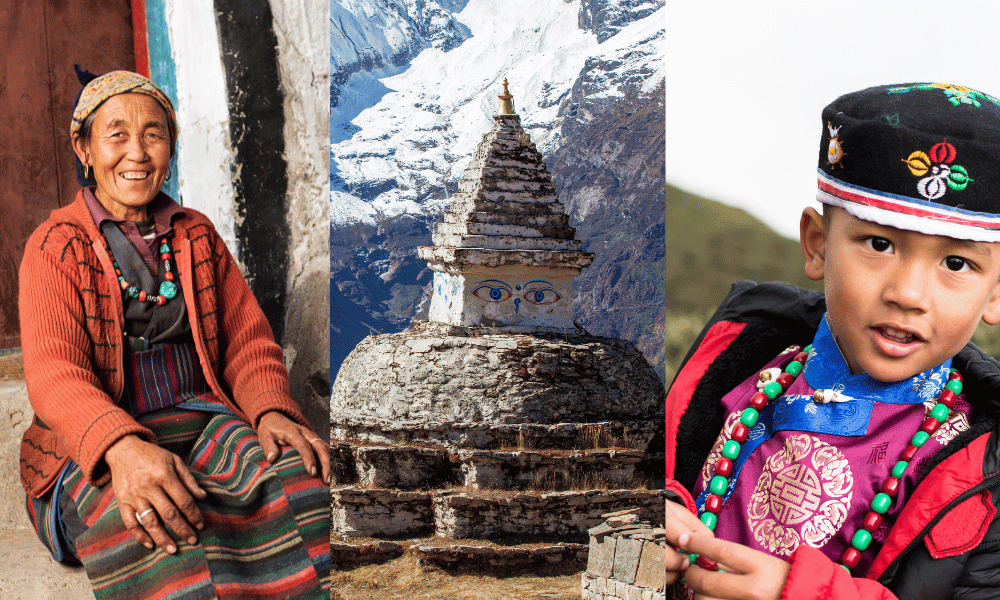
The Sherpa people are the predominant ethnic group in the Khumbu region, renowned for their mountaineering skills, warm hospitality, and rich cultural heritage. Originally from Tibet, Sherpas migrated to the Nepalese Himalayas several centuries ago and have since adapted to the high-altitude environment. They primarily follow Tibetan Buddhism and have a strong connection to the mountains, which they consider sacred.
Some essential aspects of Sherpa customs include:
Hospitality: Sherpas are known for their warm and welcoming nature, making visitors feel at home in their teahouses and villages.
Prayer flags: Colorful prayer flags are a common sight in the Khumbu region. They bear sacred Buddhist mantras and are believed to spread goodwill and compassion with the wind.
Mani stones: These stones are engraved with Buddhist mantras or prayers and are often found along the trekking trails or near religious sites. It's customary to walk around these stones in a clockwise direction to show respect.
Khata: A traditional ceremonial scarf offered during special occasions, such as welcoming guests or bidding farewell. It symbolizes goodwill, compassion, and respect.
Namche Bazaar and its surrounding areas are home to several religious sites and monasteries that reflect the spiritual beliefs of the Sherpa community. Some notable places to visit include:
Namche Monastery: Located within Namche Bazaar, this monastery is an important religious and cultural center for the local Sherpa community. It houses ancient Buddhist scriptures, artifacts, and beautiful murals.
Tengboche Monastery: Situated on the trail to Everest Base Camp, about a day's trek from Namche Bazaar, Tengboche Monastery is one of the most famous and largest monasteries in the Khumbu region. It offers panoramic views of the Himalayas and hosts the vibrant Mani Rimdu festival annually.
Khumjung Monastery: Nestled in the picturesque village of Khumjung, this monastery is known for housing a purported Yeti scalp, a legendary creature in Sherpa folklore.
Sherpa culture is enriched by various traditional festivals and events that showcase their customs, music, dance, and religious beliefs. Some significant festivals in the Khumbu region include:
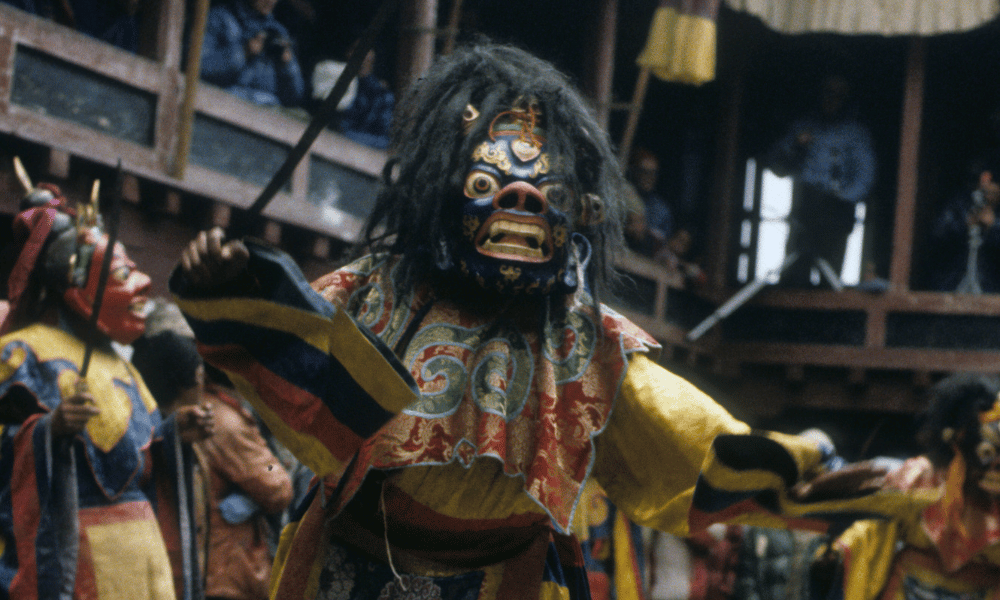
Mani Rimdu: Celebrated at Tengboche Monastery, this vibrant festival features masked dances, traditional music, and religious ceremonies performed by the monks. It usually takes place in October or November, depending on the Tibetan lunar calendar.
Dumji: This annual festival is celebrated in various Sherpa villages, including Namche Bazaar, to honor the Buddhist saint Padmasambhava. It involves colorful masked dances, traditional music, and feasting.
Losar: The Sherpa and Tibetan New Year, Losar is celebrated with much fanfare, including family gatherings, feasting, and traditional rituals.
By immersing yourself in the rich culture and traditions of the Sherpa people during your visit to Namche Bazaar, you'll gain a deeper understanding and appreciation of their unique way of life in the majestic Himalayas.
Below we have linked some of the top attractions in and around Namche Bazaar. We have also mentioned the activities that you can try to enjoy your time in Namche Bazaar to the fullest.
A popular acclimatization hike from Namche Bazaar is to the Everest View Hotel, which offers stunning panoramic views of Mount Everest, Lhotse, Ama Dablam, and other surrounding peaks. The hotel, located at an altitude of 3,880 meters (12,730 feet), is considered one of the highest luxury hotels in the world. The hike takes approximately 2-3 hours round trip, depending on your pace.
The weekly Saturday market in Namche Bazaar is a vibrant and bustling event, where locals and traders from nearby villages gather to buy and sell various goods, including food, clothes, and traditional handicrafts. It's a great opportunity to experience the local atmosphere, sample street food, and purchase unique souvenirs.
Located near the entrance of Namche Bazaar, the Sagarmatha National Park Visitor Center provides valuable information about the region's flora, fauna, and the Sherpa culture. The center also showcases photographs and exhibits on the history of mountaineering in the Everest region.
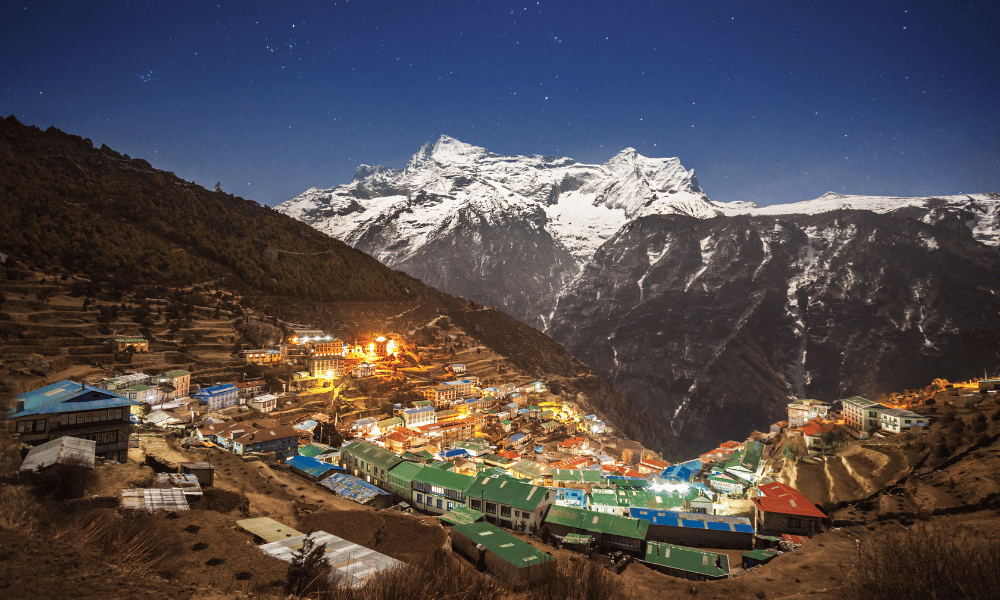
A visit to the nearby traditional Sherpa villages of Khumjung and Thame offers a glimpse into the local way of life, far from the tourist trail. Khumjung is known for its picturesque monastery and the Khumjung Hillary School, while Thame is famous for its ancient monastery and the beautiful landscape. Both villages can be reached through day hikes from Namche Bazaar.
At an altitude of 3,780 meters (12,402 feet), Syangboche Airstrip is one of the highest airstrips in the world, although it's no longer in commercial use. The short hike to the airstrip provides a unique vantage point to admire the breathtaking views of the surrounding mountains and valleys.
This memorial stupa, situated on a hill above Namche Bazaar, pays tribute to Tenzing Norgay, the legendary Sherpa mountaineer who, along with Sir Edmund Hillary, became the first person to summit Mount Everest in 1953. The site offers a peaceful atmosphere and sweeping views of Namche Bazaar and the surrounding peaks.
By exploring these attractions and engaging in various activities, you can make the most of your visit to Namche Bazaar, deepening your understanding of the region's natural beauty, history, and cultural heritage.
The key to preventing altitude sickness while climbing to high-altitude places such as Namche Bazaar is allowing your body sufficient time to adjust to the decreasing oxygen levels and air pressure as you ascend. Gradual acclimatization helps your body adapt to these changes and reduces the risk of altitude sickness.
Acclimatization is a crucial aspect of any high-altitude trek, including the journey to Everest Base Camp. As you ascend to higher elevations, the air pressure and oxygen levels decrease, which can lead to altitude sickness if your body doesn't have time to adjust. Namche Bazaar, situated at 3,440 meters (11,286 feet), is a popular acclimatization stop for trekkers, allowing the body to adapt to the lower oxygen levels before continuing to higher elevations. Proper acclimatization minimizes the risk of developing altitude sickness and ensures a safer and more enjoyable trekking experience.
Altitude sickness, also known as Acute Mountain Sickness (AMS), can affect anyone, regardless of age, fitness, or previous experience at high altitudes. Symptoms usually appear within 6-24 hours after reaching an elevation above 2,500 meters (8,202 feet) and may include:
Headache
Dizziness
Nausea or vomiting
Fatigue
Shortness of breath
Difficulty sleeping
Loss of appetite
In severe cases, altitude sickness can progress to High Altitude Cerebral Edema (HACE) or High Altitude Pulmonary Edema (HAPE), both of which can be life-threatening if not treated promptly.
To minimize the risk of altitude sickness and maintain good health during your trek, follow these recommendations:
Gradual ascent: Ascend slowly and allow your body to adjust to the lower oxygen levels. Most trekking itineraries include acclimatization days, such as a rest day in Namche Bazaar, to help prevent altitude sickness.
Stay hydrated: Drink plenty of water (at least 3-4 liters per day) to stay well-hydrated, as dehydration can exacerbate altitude sickness symptoms.
Avoid alcohol and tobacco: Consumption of alcohol and tobacco can impair your body's ability to acclimatize and increase the risk of altitude sickness.
Eat a balanced diet: Consume a diet rich in carbohydrates, as they provide energy more efficiently at high altitudes. Also, eat regular meals to maintain your energy levels.
Take it easy: Rest when needed, and avoid overexertion. Listen to your body and pace yourself according to your comfort level.
Sleep well: Get enough sleep to help your body recover and acclimatize properly.
Medications: Consult your doctor before your trek to discuss whether medications like Diamox (acetazolamide) might be appropriate for you to prevent altitude sickness.
Know when to descend: If you or anyone in your group starts to experience severe altitude sickness symptoms, it's crucial to descend to a lower elevation immediately and seek medical attention.
By following these tips and prioritizing acclimatization, you can reduce the risk of altitude sickness and enjoy a healthier, safer trekking experience in the Everest region.
As visitors to restricted areas, the responsibility to leave the place as is if not better lies upon our shoulders. There are several ways in which you can contribute to the sustainability of the region and promote responsible tourism.
The Everest region faces various environmental challenges, such as deforestation, waste management, and the impact of climate change on glaciers and ecosystems. As a responsible tourist, it's essential to be aware of these issues and minimize your impact on the environment. Here are some ways to address environmental concerns:
Use refillable water bottles: Single-use plastic bottles contribute to waste and pollution. Bring a refillable water bottle and use water purification methods like purification tablets, filters, or UV sterilizers to minimize plastic waste.
Save energy: Conserve electricity by turning off lights and electronic devices when not in use. Be mindful that energy resources are scarce in remote mountain areas.
Minimize waste: Dispose of your trash responsibly and pack out any non-biodegradable waste. Use reusable bags and avoid single-use items.
Respect wildlife: Observe wildlife from a distance, do not feed them, and avoid disturbing their natural habitats.
Responsible tourism involves supporting the local economy and promoting sustainable development in the communities you visit. Here are some ways to support local businesses and communities:
Stay in locally-owned accommodations: Choose tea houses, lodges, or hotels owned and operated by local families, which helps keep money within the community.
Hire local guides and porters: Employing local guides and porters provides them with a source of income and supports their families.
Purchase local products: Buy handicrafts, food, and souvenirs from local artisans and vendors to contribute to the local economy.
Respect local customs and traditions: Be mindful of local customs, dress modestly, and ask for permission before photographing people or religious sites.
The Leave No Trace principles provide guidelines for minimizing your impact on the environment and preserving natural resources for future generations. These principles include:
Plan ahead and prepare: Research your destination, understand the local regulations, and ensure you have appropriate equipment and clothing.
Travel and camp on durable surfaces: Stick to established trails and campsites to minimize erosion and damage to vegetation.
Dispose of waste properly: Pack out all trash, leftover food, and litter, and use designated toilet facilities whenever possible.
Leave what you find: Do not remove natural or cultural artifacts, and avoid damaging plants or geological features.
Minimize campfire impact: Use portable stoves for cooking instead of making campfires, as firewood is scarce and deforestation is a concern in the Everest region.
Respect wildlife: Do not approach or feed wildlife, and store your food and trash securely to avoid attracting animals.
Be considerate of other visitors: Keep noise levels down, respect the privacy of others, and follow established trail etiquette.
By practicing responsible tourism and sustainable practices, you can contribute to the preservation of Namche Bazaar and the Everest region for generations to come.
In this detailed guide on Namche Bazaar, we've discussed its unique location and importance as the gateway to Everest Base Camp, the history and development of the town, various accommodation and dining options, the rich culture and traditions, top attractions and activities, acclimatization and health tips, and the importance of responsible tourism and sustainable practices.
We encourage you to visit Namche Bazaar and immerse yourself in the unique culture and breathtaking beauty of the Khumbu region. By following the tips and suggestions provided in this guide, you can have a memorable, enjoyable, and responsible travel experience in this remarkable part of the world.
We'd love to hear about your experiences, so please feel free to share your stories, ask questions, or provide feedback on the blog post in the comments section below. Your insights and contributions will help other travelers make the most of their visit to Namche Bazaar and the Khumbu region.
Namche Bazaar is located in the Khumbu region in northeastern Nepal. After Phakding, Namche Bazaar is the resting stop for trekking in the Everest region.
It typically takes two days to trek from Lukla to Namche Bazaar, with an overnight stop in Phakding or another village along the way.
Yes, there are a few ATMs in Namche Bazaar; however, they may not always be reliable due to power outages or connectivity issues. It's advisable to carry sufficient cash from Kathmandu or other major cities.
Yes, most tea houses, lodges, and hotels offer Wi-Fi, although the connection may be slow or intermittent. Some establishments may charge a fee for internet access.
Drinking untreated tap water is not recommended due to potential contamination. It's advisable to drink boiled, filtered, or treated water. Many tea houses and lodges provide safe drinking water, or you can use water purification tablets, filters, or UV sterilizers.
Yes, altitude sickness is a risk when visiting Namche Bazaar due to its elevation. Proper acclimatization, hydration, and following the tips provided in the blog post can help minimize the risk.
The best time to visit Namche Bazaar is during the spring (March-May) and autumn (September-November) seasons, when the weather is relatively stable, and the mountain views are clear.
It's recommended to spend at least one full day (two nights) in Namche Bazaar for acclimatization before continuing to higher elevations.
Most accommodations in Namche Bazaar offer charging facilities for electronic devices, although there may be a small fee. It's a good idea to bring a portable charger or extra batteries as backup.
Namche Bazaar has a medical clinic and a few pharmacies where you can access basic medical care and purchase common medications. For more serious medical concerns, it's advised to return to Lukla or seek assistance in Kathmandu.